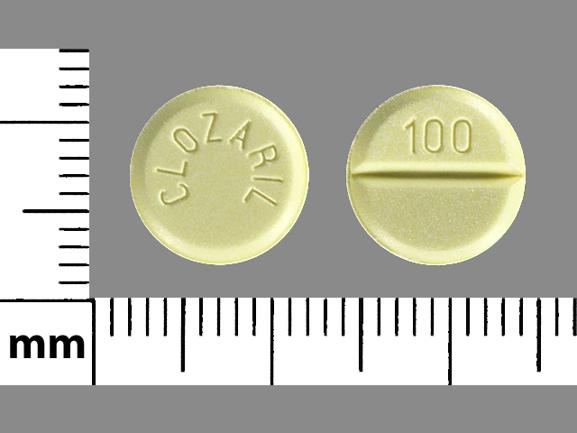Clozaril Dosage
Generic name: CLOZAPINE 25mg
Dosage form: tablet
Drug class: Atypical antipsychotics
Medically reviewed by Drugs.com. Last updated on May 23, 2023.
Required Laboratory Testing Prior to Initiation and During Therapy
Prior to initiating treatment with CLOZARIL, a baseline ANC must be obtained. The baseline ANC must be at least 1500/µL for the general population, and at least 1000/µL for patients with documented Benign Ethnic Neutropenia (BEN). To continue treatment, the ANC must be monitored regularly [see Warnings and Precautions (5.1)].
Dosing Information
The starting dose is 12.5 mg once daily or twice daily. The total daily dose can be increased in increments of 25 mg to 50 mg per day, if well-tolerated, to achieve a target dose of 300 mg to 450 mg per day (administered in divided doses) by the end of 2 weeks. Subsequently, the dose can be increased once weekly or twice weekly, in increments of up to 100 mg. The maximum dose is 900 mg per day. To minimize the risk of orthostatic hypotension, bradycardia, and syncope, it is necessary to use this low starting dose, gradual titration schedule, and divided dosages [see Warnings and Precautions (5.3)].
CLOZARIL can be taken with or without food [see Pharmacokinetics (12.3)].
Maintenance Treatment
Generally, patients responding to CLOZARIL should continue maintenance treatment on their effective dose beyond the acute episode.
Discontinuation of Treatment
Method of treatment discontinuation will vary depending on the patient’s last ANC:
- •
- See Tables 2 or 3 for appropriate ANC monitoring based on the level of neutropenia if abrupt treatment discontinuation is necessary because of moderate to severe neutropenia.
- •
- Reduce the dose gradually over a period of 1 to 2 weeks if termination of CLOZARIL therapy is planned and there is no evidence of moderate to severe neutropenia.
- •
- For abrupt clozapine discontinuation for a reason unrelated to neutropenia, continuation of the existing ANC monitoring is recommended for general population patients until their ANC is ≥1500/µL and for BEN patients until their ANC is ≥1000/µL or above their baseline.
- •
- Additional ANC monitoring is required for any patient reporting onset of fever (temperature of 38.5°C or 101.3°F, or greater) during the 2 weeks after discontinuation [see Warnings and Precautions (5.1)].
- •
- Monitor all patients carefully for the recurrence of psychotic symptoms and symptoms related to cholinergic rebound such as profuse sweating, headache, nausea, vomiting, and diarrhea.
Re-Initiation of Treatment
When restarting CLOZARIL in patients who have had even a brief interruption in treatment with CLOZARIL dosage must be reduced. This is necessary to minimize the risk of hypotension, bradycardia, and syncope [see Warnings and Precautions (5.3)]. If one day’s dosing has been missed, resume treatment at 40% to 50% of the established dose. If two days dosing have been missed, resume dose at approximately 25% of the established dosage. For longer interruptions, re-initiate at a dosage of 12.5 mg once daily or twice daily. If these dosages are well-tolerated, the dosage may be increased to the previous dosage more quickly than recommended for initial treatment.
Dosage Adjustments with Concomitant use of CYP1A2, CYP2D6, CYP3A4 Inhibitors or CYP1A2, CYP3A4 Inducers
Dose adjustments may be necessary in patients with concomitant use of: strong CYP1A2 inhibitors (e.g., fluvoxamine, ciprofloxacin, or enoxacin); moderate or weak CYP1A2 inhibitors (e.g., oral contraceptives, or caffeine); CYP2D6 or CYP3A4 inhibitors (e.g., cimetidine, escitalopram, erythromycin, paroxetine, bupropion, fluoxetine, quinidine, duloxetine, terbinafine, or sertraline); CYP3A4 inducers (e.g., phenytoin, carbamazepine, St. John’s wort, and rifampin); or CYP1A2 inducers (e.g., tobacco smoking) (Table 1) [see Drug Interactions (7)].
|
Co-medications |
Scenarios |
||
|
Initiating CLOZARIL while taking a co-medication |
Adding a co-medication while taking CLOZARIL |
Discontinuing a co-medication while continuing CLOZARIL |
|
|
Strong CYP1A2 Inhibitors |
Use one-third of the CLOZARIL dose. |
Increase CLOZARIL dose based on clinical response. |
|
|
Moderate or Weak CYP1A2 Inhibitors |
Monitor for adverse reactions. Consider reducing the CLOZARIL dose if necessary. |
Monitor for lack of effectiveness. Consider increasing CLOZARIL dose if necessary. |
|
|
CYP2D6 or CYP3A4 Inhibitors |
|||
|
Strong CYP3A4 Inducers |
Concomitant use is not recommended. However, if the inducer is necessary, it may be necessary to increase the CLOZARIL dose. Monitor for decreased effectiveness. |
Reduce CLOZARIL dose based on clinical response. |
|
|
Moderate or weak CYP1A2 or CYP3A4 Inducers |
Monitor for decreased effectiveness. Consider increasing the CLOZARIL dose if necessary. |
Monitor for adverse reactions. Consider reducing the CLOZARIL dose if necessary. |
|
More about Clozaril (clozapine)
- Check interactions
- Compare alternatives
- Pricing & coupons
- Reviews (15)
- Drug images
- Latest FDA alerts (8)
- Side effects
- During pregnancy
- Generic availability
- Drug class: atypical antipsychotics
- Breastfeeding
- En español
Patient resources
Other brands
Professional resources
Other brands
Related treatment guides
Further information
Always consult your healthcare provider to ensure the information displayed on this page applies to your personal circumstances.


